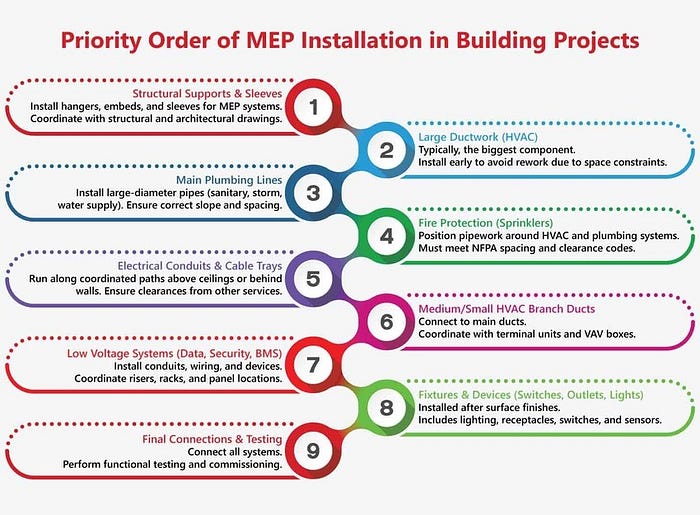The Trade Sequencing Mistake That Costs MEP Contractors $50k/Project
The Hidden Cost of Poor Trade Sequencing
You’re halfway through the project, and suddenly, ductwork clashes with structural steel. The plumber’s already installed the pipes. The GC is furious. Sound familiar?
This scenario plays out far too often in small to mid-sized MEP firms, where poor trade sequencing during coordination leads to last-minute changes, field rework, and costly delays. These aren’t just minor hiccups; for every project where sequencing is ignored or mismanaged, MEP contractors can lose up to $50,000 per project due to:
- Labor hours spent on rework
- Material waste from misfabrication
- Crew downtime waiting for resolution
- Penalties from missed deadlines
The frustrating part? These losses are preventable.
In this article, we’ll break down what trade sequencing really means in the context of MEP coordination, the key missteps that lead to coordination breakdowns, and how leading MEP teams are resolving it with smarter workflows, not bigger teams.
Let’s dissect the mistake that’s quietly draining your margins — and how to stop it.
Let’s Define — What is Trade Sequencing?
Trade sequencing in MEP coordination refers to the planned order in which various mechanical, electrical, plumbing, and fire protection systems are designed, modeled, and installed, both virtually and on-site. It’s not just about who goes first; it’s about how each trade aligns with structural, architectural, and other systems to minimize clashes and rework.
Without proper sequencing:
- Coordination becomes reactive instead of proactive
- Fabrication is based on outdated or conflicting layouts
- On-site crews face delays due to unresolved overlaps
Effective trade sequencing ensures smooth handoffs, accurate prefabrication, and fewer costly surprises in the field.
Download MEP Coordination Checklist to Avoid Costly Sequencing Mistakes
The Costly Mistakes of Poor Trade Sequencing in MEP Projects
Trade sequencing refers to the planned order in which MEP subcontractors execute their scope of work during construction.
It plays a critical role in ensuring that each system is installed efficiently, without conflicts or costly rework. Yet, this is where many MEP firms lose control.
The Problem:
Improper sequencing can derail a project. Take this common example: electrical rough-ins are completed before HVAC ductwork is installed. When duct routes are later finalized, they clash with conduit paths, forcing the electrical team to reroute systems at their own cost, burning time, labor, and materials. Multiply this across multiple trades, and the budget spirals quickly.
Why It Happens?
- Lack of pre-construction BIM coordination: Without early alignment through BIM or design meetings, trades work in isolation, unaware of spatial conflicts.
- Assumptions about “standard” sequencing: Teams follow outdated rules of thumb without validating them against the actual building design.
- Design conflicts or last-minute changes: Incomplete or late design updates can disrupt even a well-planned sequence, leading to reactive decisions in the field.
For MEP firms, these issues are not just frustrating; they’re expensive. Addressing them requires proactive MEP BIM coordination and trade-specific 3D modeling strategies that prevent missteps long before boots hit the jobsite.
Why Small MEP Firms Suffer Most from Trade Sequencing Mistakes
Small and mid-sized MEP firms are especially vulnerable to trade sequencing errors, not because of a lack of skill, but due to resource constraints and workflow gaps.
Here’s why the impact hits harder for Small and mid-sized MEP firms :
- Limited BIM expertise or in-house coordination teams means clashes are often detected too late, if at all.
- Coordination tends to be reactive, handled only when issues arise on-site rather than during design.
The result? Cost overruns, project delays, and frustrated clients.

Fixing the Problem: Strategies to Optimize Trade Sequencing
The most effective way to prevent costly trade sequencing errors is to shift from reactive coordination to proactive planning, starting early with a well-defined BIM Execution Plan (BEP). This foundational document sets the tone for how trades will collaborate, coordinate, and sequence their work throughout the project lifecycle.
Explore More : The Trade Sequencing Mistake That Costs MEP Contractors $50k/Project




Comments
Post a Comment